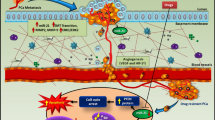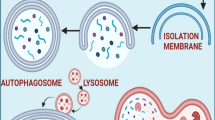Summary
Our previous studies have revealed the important roles of the nonseed regions of microRNAs (miRNAs) in gene regulation, which provided novel insight into the development of miRNA analogs for cancer therapy. Here, we altered each nucleotide in the nonseed region of miR-34a and obtained novel synthetic miRNA analogs. Among them, AM22, with a base alteration from G to C at the 17th nucleotide of miR-34a, showed extensive antiproliferative activity against several colorectal tumor cell lines and achieved effective inhibition of core binding factor subunit β (CBFB) expression. Subsequent investigations demonstrated that AM22 directly targeted CBFB by binding to its 3'-untranslated region (3'-UTR). Inhibition of CBFB showed obvious antiproliferative activity on HCT-116 and SW620 cells. Furthermore, the antiproliferative effects of AM22 on these cells were also measured in xenograft mouse models. In conclusion, this study identified AM22 as a potential antitumor miRNA by targeting CBFB and provided a new design approach for miRNA-based cancer treatment by changing the nonseed region of miRNA.




Similar content being viewed by others
Data availability
Sets of data or summaries generated during the present study are available from the corresponding author upon reasonable request.
References
Dekker E, Rex D (2018) Advances in CRC Prevention: Screening and Surveillance. Gastroenterology 154(7):1970–1984
Troiani T, Napolitano S, Corte CD, Martini G, Martinelli E, Morgillo F, Ciardiello F (2016) Therapeutic value of EGFR inhibition in CRC and NSCLC: 15years of clinical evidence. Esmo Open 1: e000088
Bartel D (2004) MicroRNAs Genomics, Biogenesis, Mechanism, and Function. Cell 116:281–297
Esquela-Kerscher A, Slack F (2006) Oncomirs- microRNAs with a role in cancer. Nat Rev Cancer 6:259–269
Lu J, Getz G, Miska EA et al (2005) MicroRNA expression profiles classify human cancers. Nature 435:834–838. https://doi.org/10.1038/nature03702
Calin GA, Croce CM (2006) MicroRNA signatures in human cancers. Nat Rev Cancer 6:857–866. https://doi.org/10.1038/nrc1997
Eva S, Zoran C, Ján R, Karel S (2017) Alternative mechanisms of miR-34a regulation in cancer. Cell Death Dis 8: e3100
Misso G, Martino MTD, Rosa GD et al. (2014) Mir-34: A New Weapon Against Cancer? Mol. Ther Nucleic Acids 3 9:e194
Tarasov V, Jung P, Verdoodt B, Lodygin D, Epanchintsev A, Menssen A, Meister G, Hermeking H (2007) Differential Regulation of microRNAs by p53 Revealed by Massively Parallel Sequencing: miR-34a is a p53 Target That Induces Apoptosis and G1-arrest. Cell Cycle 6:1586–1593
Geng D, Song X, Ning F, Song Q, Yin H (2015) MiR-34a Inhibits Viability and Invasion of Human Papillomavirus-Positive Cervical Cancer Cells by Targeting E2F3 and Regulating Survivin. Int J Gynecol Cancer 25:707–713
Adams BD, Parsons C, Slack F (2016) The tumor-suppressive and potential therapeutic functions of miR-34a in epithelial carcinomas. Expert Opin Ther Targets 20:737–753
Mackiewicz M, Huppi K, Pitt JJ, Dorsey TH, Ambs S, Caplen NJ (2011) Identification of the receptor tyrosine kinase AXL in breast cancer as a target for the human miR-34a microRNA. Breast Cancer Res Treat 130:663–679
Rokavec M, Öner MG, Li H et al (2014) IL-6R/STAT3/miR-34a feedback loop promotes EMT-mediated colorectal cancer invasion and metastasis. J Clin Investig 124(4):1853–1867
Gao J, Li N, Dong Y et al (2014) miR-34a-5p suppresses colorectal cancer metastasis and predicts recurrence in patients with stage II/III colorectal cancer. Oncogene 34:4142–4152
Meng F, Chen Y, Yang M, Zhang H, Wang W (2021) Concomitant inhibition of B7–H3 and PD-L1 expression by a novel and synthetic microRNA delivers potent antitumor activities in colorectal tumor models. Invest New Drugs. https://doi.org/10.1007/s10637-021-01123-4
Lewis BP, Shih I, Jones-Rhoades M, Bartel D, Burge C (2003) Prediction of Mammalian MicroRNA Targets. Cell 115:787–798
Bader AG, Brown D, Winkler M (2010) The Promise of MicroRNA Replacement Therapy. Cancer Res 70:7027–7030
Pipan V, Zorc M, Kunej T (2015) MicroRNA Polymorphisms in Cancer: A Literature Analysis. Cancers (Basel) 7:1806–1814
Zhao D (2020) Single nucleotide alterations in MicroRNAs and human cancer-A not fully explored field. Non-coding RNA Research 5:27–31
Chipman LB, Pasquinelli AE (2019) miRNA Targeting: Growing beyond the Seed. Trends Genet 35(3):215–222
Sheu-Gruttadauria J, Xiao Y, Gebert LFR, MacRae I (2019) Beyond the seed: structural basis for supplementary microRNA targeting by human Argonaute2. EMBO J 13: e101153
Broughton JP, Lovci MT, Huang JL, Yeo GW, Pasquinelli AE (2016) Pairing beyond the Seed Supports MicroRNA Targeting Specificity. Mol Cell 64:320–333. https://doi.org/10.1016/j.molcel.2016.09.004
Thangavel G, Nayar S (2018) A Survey of MIKC Type MADS-Box Genes in Non-seed Plants: Algae, Bryophytes. Lycophytes and Ferns Front Plant Sci 9:510
Gang H, Shigesada K, Ito K, Wee HJ, Yokomizo T, Ito Y (2014) Dimerization with PEBP2β protects RUNX1/AML1 from ubiquitin–proteasome-mediated degradation. EMBO J 20:723–733
Malik N, Yan H, Moshkovich N et al (2019) The transcription factor CBFB suppresses breast cancer through orchestrating translation and transcription. Nat Commun 10:2071. https://doi.org/10.1038/s41467-019-10102-6
Gonzales F, Barthélémy A, Peyrouze P, Fenwarth L, Preudhomme C, Duployez N, Cheok M (2021) Targeting RUNX1 in acute myeloid leukemia: preclinical innovations and therapeutic implications. Expert Opin Ther Targets 25:299–309
Lee-Thacker S, Choi Y, Taniuchi I, Takarada T, Yoneda Y, Ko C, Jo M (2018) Core Binding Factor 2 Expression in Ovarian Granulosa Cells Is Essential for Female Fertility. Endocrinology 159(5):2094–2109
Davis JN, Rogers D, Adams L et al (2010) Association of core-binding factor β with the malignant phenotype of prostate and ovarian cancer cells. J Cell Physiol 225: 875–887
Sandberg K, Samson WK, Ji H (2013) Decoding noncoding RNA: the long and short of it. Circ Res 113:240
Acunzo M, Romano G, Nigita G et al (2017) Selective targeting of point-mutated KRAS through artificial microRNAs. Proc Natl Acad Sci USA 114:E4203–E4012
Hong DS, Kang YK, Borad M et al (2020) Phase 1 study of MRX34, a liposomal miR-34a mimic, in patients with advanced solid tumours. Br J Cancer 122:1630–1637. https://doi.org/10.1038/s41416-020-0802-1
Wang X, Li J, Dong K et al (2015) Tumor suppressor miR-34a targets PD-L1 and functions as a potential immunotherapeutic target in acute myeloid leukemia. Cell Signal 27:443–452
Mohan M, Kumar V, Lackner A, Alvarez X (2015) Dysregulated miR-34a SIRT1 Acetyl p65 Axis Is a Potential Mediator of Immune Activation in the Colon during Chronic Simian Immunodeficiency Virus Infection of Rhesus Macaques. J Immunol 194:291–306
Acknowledgements
Not applicable.
Funding
This research was supported by the National Natural Science Foundation of China (No. 81773044), Social Development Project of Jiangsu Province (BE2019657), Qinglan Project of Jiangsu Province, and the Priority Academic Program Development of Jiangsu Higher Education Institutions (PAPD).
Author information
Authors and Affiliations
Contributions
Conceptulization: Meng and Wang. Study design and execution: Meng, Li and Qiu. Data analysis and summary: Meng and Li. Writing—original draft: Meng and Zhang. Writing—review & editing: Meng, Zhang and Wang.
Corresponding authors
Ethics declarations
Ethics approval and consent to participate
Not applicable.
Research involving human participants and/or animals
Protocols for animal husbandry and experiments were approved by the Institutional Animal Care and Use Committee at Soochow University. All animal experiments complied with the ARRIVE guidelines and were carried out in accordance with the National Institutes of Health Guide for the Care and Use of Laboratory Animals (NIH Publications No. 8023, revised 1978).
Informed consent
Not applicable.
Consent for publication
All authors consented to publish this study in Investigational New Drugs.
Competing interests
The authors declare no competing interests.
Additional information
Publisher's Note
Springer Nature remains neutral with regard to jurisdictional claims in published maps and institutional affiliations.
Supplementary Information
Below is the link to the electronic supplementary material.
Rights and permissions
About this article
Cite this article
Meng, F., Li, J., Qiu, Y. et al. AM22, a novel synthetic microRNA, inhibits the proliferation of colorectal cancer cells by targeting core binding factor subunit β (CBFB). Invest New Drugs 40, 469–477 (2022). https://doi.org/10.1007/s10637-021-01208-0
Received:
Accepted:
Published:
Issue Date:
DOI: https://doi.org/10.1007/s10637-021-01208-0




